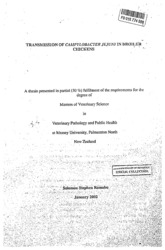Transmission of campylobacter Jejuni in broiler chickens
Abstract
Investigations were carried out aimed at identifying potential sources of transmission of Campylobacter jejuni to broiler chickens, determining whether boots can mechanically transmit C. jejuni to susceptible chickens, determining the transmission rate of C. jejuni in broiler chickens, and assessing the effect of washing slaughterhouse fomites with chlorinated water on the level of C. jejuni contamination during the day. Bacteriological culture of samples taken in the premises of a broiler slaughterhouse showed that after washing and just before departure for depopulation of broiler farms, 75%, 58.33%, 47.22%, 50%, 54.29%, 66.67%, 31.25%, and 0% of pallets, crates,truck beds, truck wheels, drivers’ boots, catchers’ boots, forklift wheels, and tractor wheels respectively, were contaminated with C. jejuni. Therefore it was concluded that slaughterhouse personnel and fomites could potentially transmit C. jejuni during partial depopulation of broiler flocks. The level of C. jejuni in consecutive sample batches of fomites (n = 30) that were collected in six periods of one hour each day (hence six batches), between 0530 and 1230 hrs, over six days, was found to range from 44.83% in the 1*' batch and 66.67% in the 5th batch, indicating that washing fomites with pressurized chlorinated water makes no statistically significant difference (p>0.05) in the contamination level. The fomites sampled were pallets, crates, truck bed, truck wheels, and drivers’ boots. Susceptible broiler chickens became colonized with C. jejuni after exposure to boots that had been worn in a pen with infected chickens demonstrating that boots can mechanically cause horizontal transmission of the bacterium. A transmission study conducted by introducing a bird infected with C. jejuni to 99 susceptible chickens demonstrated a rapid spread of the infection to all the birds within 48 hours and a transmission rate best represented by a simple epidemic curve. A transmission parameter beta (P), with a value of 2.1 x 10‘3 ± 0.013 x 1 O’3 (mean ± standard error), was calculated by fitting the data into a simple deterministic epidemic model. The transmission rate in a population of 100 birds, predicted by this model, was very similar to that obtained in the experiment. Therefore, it was concluded that the transmission rate of C. jejuni in broilers resembles a simple epidemic.
Collections
- Theses and Dissertations [133]

